Vegan Chocolate Market Size
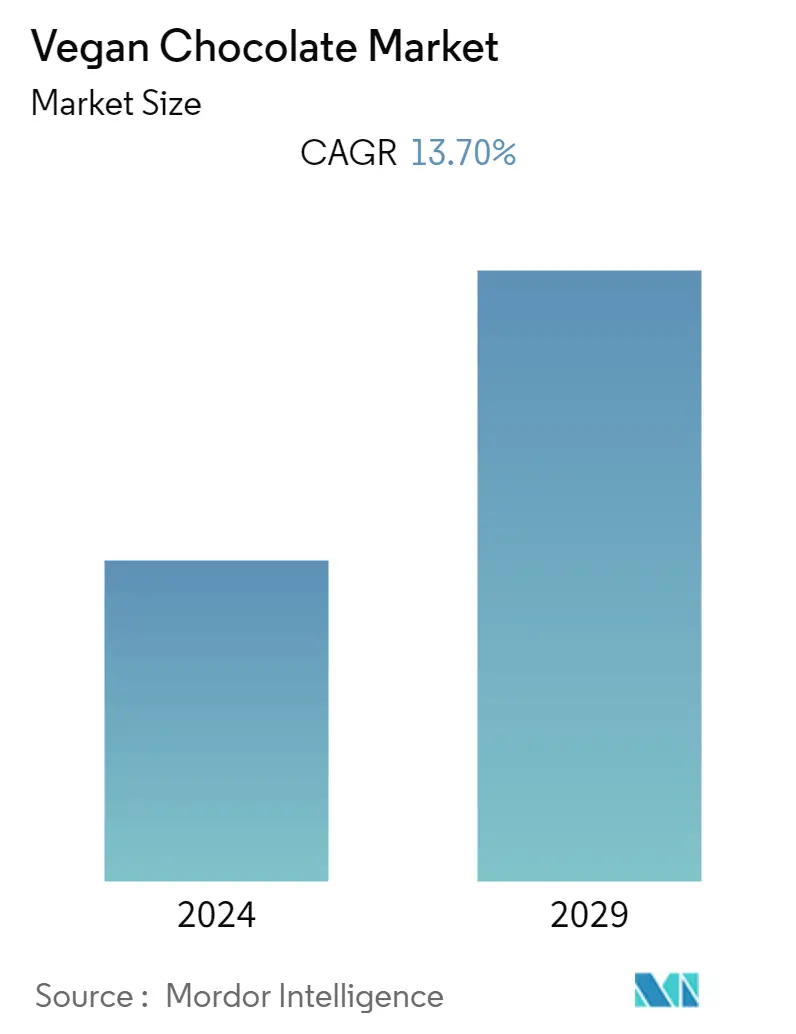
| Study Period | 2019 - 2029 |
| Base Year For Estimation | 2023 |
| CAGR | 13.70 % |
| Fastest Growing Market | Asia-Pacific |
| Largest Market | Europe |
| Market Concentration | Low |
Major Players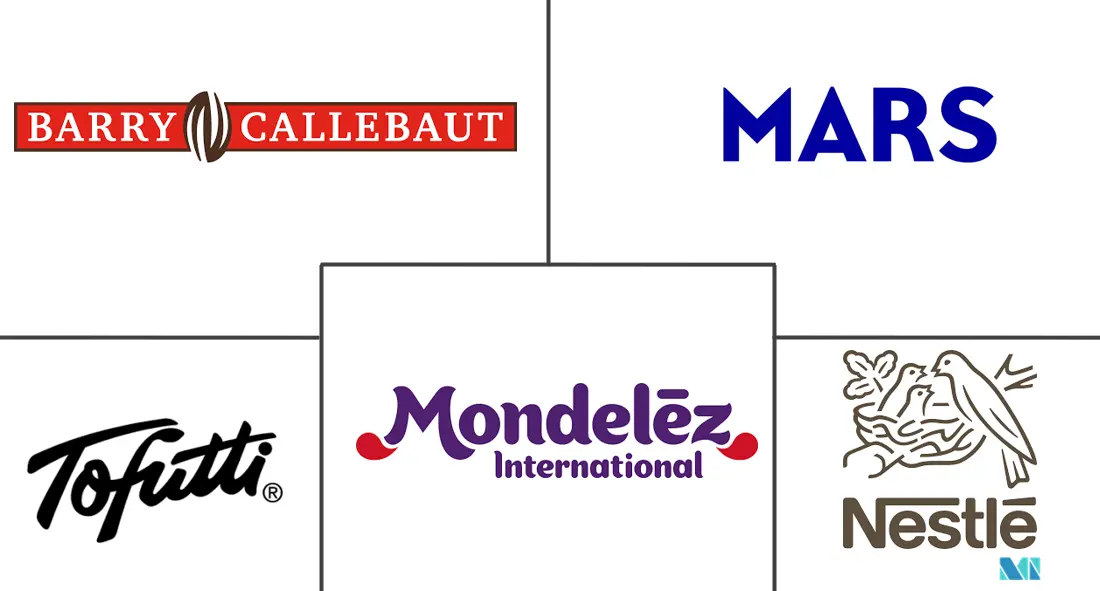
*Disclaimer: Major Players sorted in no particular order |
Vegan Chocolate Market Analysis
Global Vegan Chocolate Market is projected to register a CAGR of 13.7% during the forecast period (2022-2027).
The growing popularity of veganism among consumers across the globe, especially among millennials is a major factor driving the growth of the market. For instance, according to the vegan society, in 2014, the number of vegans in Great Britain was estimated to be 150 thousand, which increased to 600 thousand in 2019. An increasing number of environmental protection campaigns and growing awareness about animal cruelty are supporting the growth of the market. In recent years, consumers' food tastes have also changed as a result of rising food allergies and cases of lactose intolerance in both children and adults. For instance, the Food Tolerance Network reported that in 2019, almost 70% of people worldwide are lactose intolerant.
Some vegan chocolate brands also use milk substitutes like almond milk or soy milk to produce authentic vegan chocolates. For instance, in 2021, an Indian brand 'MilkinOats' has launched vegan milk chocolate made with oat milk. Their premium range, called Chalet Chokolad, is made in Swiss chalets and offers two varieties namely Chalet Velvety and Chalet Almond Crunch. Moreover, factors like concerns regarding animals' welfare in food production, the belief that vegan chocolates are healthier that boost healthy blood sugar, and the usage of alternative sweeteners like stevia in manufacturing processes are expected to boost the market at a faster pace during the forecast period.
Vegan Chocolate Market Trends
This section covers the major market trends shaping the Vegan Chocolate Market according to our research experts:
Increasing Affinity for Plant-based Diet
According to Dietetics and the British Dietetic Association and the American Academy of Nutrition, a well-planned vegan diet, which adheres to healthy eating guidelines, provides all the nutrients that a body requires and is suitable for people of all ages and stages of life. Consumers these days are looking out for health benefits before they buy any consumable products. For instance, in a survey published by the International Food Information Council and the American Heart Foundation in 2021, 43% of Americans claimed to always be on the lookout for healthy options when shopping, while 52% said they were at least sometimes scouting for healthy foods. Most consumers around the world are choosing to switch to a healthy lifestyle and an even healthier diet and this is supported by the chocolatiers making chocolates with less sugar, without dairy, and making milk chocolate with dairy-free milk like hazelnut, cashew nut, oats, etc. which is giving a cleaner, healthier, and less cloying experience. In addition, vegan chocolates contain antioxidants that give them anti-aging properties and are usually found in fruits, vegetables, grains, and nuts. Such health benefits offered by vegan chocolates are attracting consumers as manufacturers are offering products without compromising on taste and not cutting on their health.
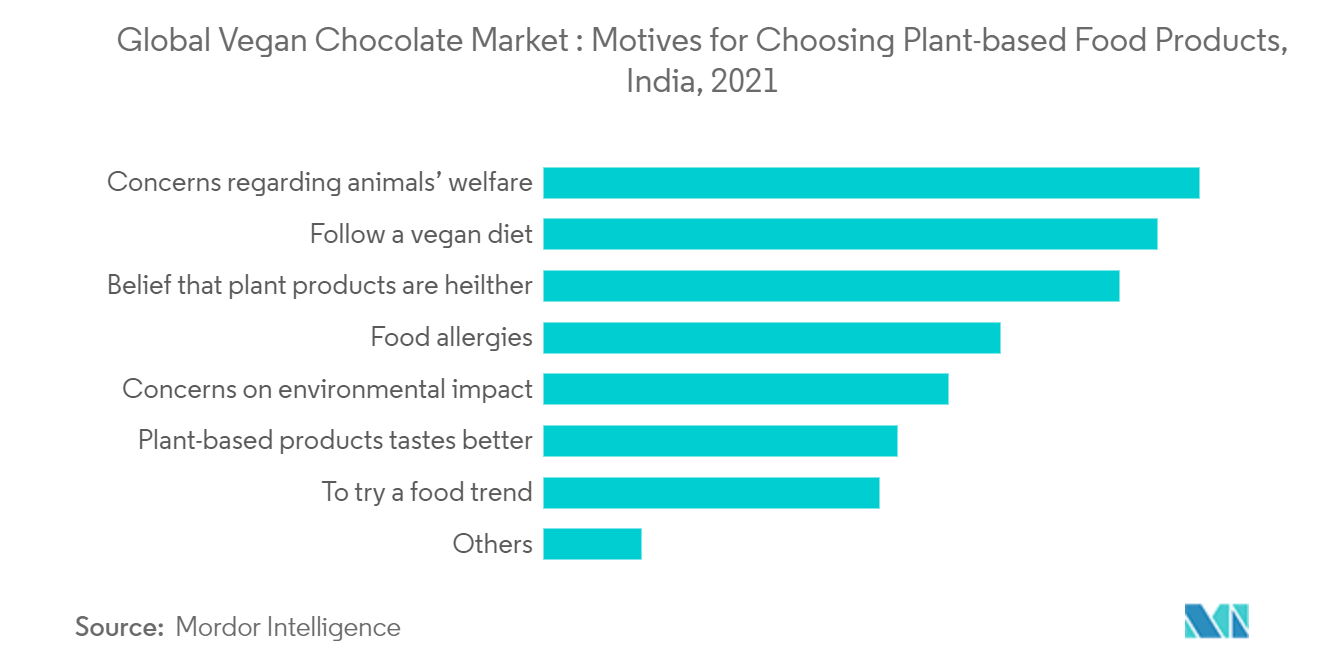
Europe Holds The Largest Market Share
The vegan chocolate market in Europe has registered significant growth in the recent past due to the ongoing acceptance of the vegan diet among the region's population. Health-conscious consumers are increasingly choosing vegan or flexitarian diets as a part of a healthy lifestyle. According to a study from the Federal Ministry of Food and Agriculture, about 35% of the population see the availability of vegetarian or vegan products as 'very important, and 63% of Germans are trying to reduce their meat consumption, making the country one of the most vegetarian places in the world. Further, a recent study by Proveg International, an international food awareness organization reveals that there are 1.3 million vegans and 8 million vegetarians across Germany. This in turn has contributed to the demand for vegan chocolate in European markets.
Moreover, festivals like Easter which is grandly celebrated in Europe are also boosting the sales of vegan chocolates as chocolates and confectionery are widely favored gifting items in the European culture. With the expanding veganism trend, consumers prefer vegan chocolates the most on such occasions which are creating substantial opportunities for the market players. Manufacturers have responded to the growing interest in plant-based diets by delivering Easter vegan chocolate and Easter-themed treats that attract customers. For instance, Lindt makes a vegan-friendly dark chocolate gold rabbit, and Divine released its new vegan dark chocolate egg with crisp mint.
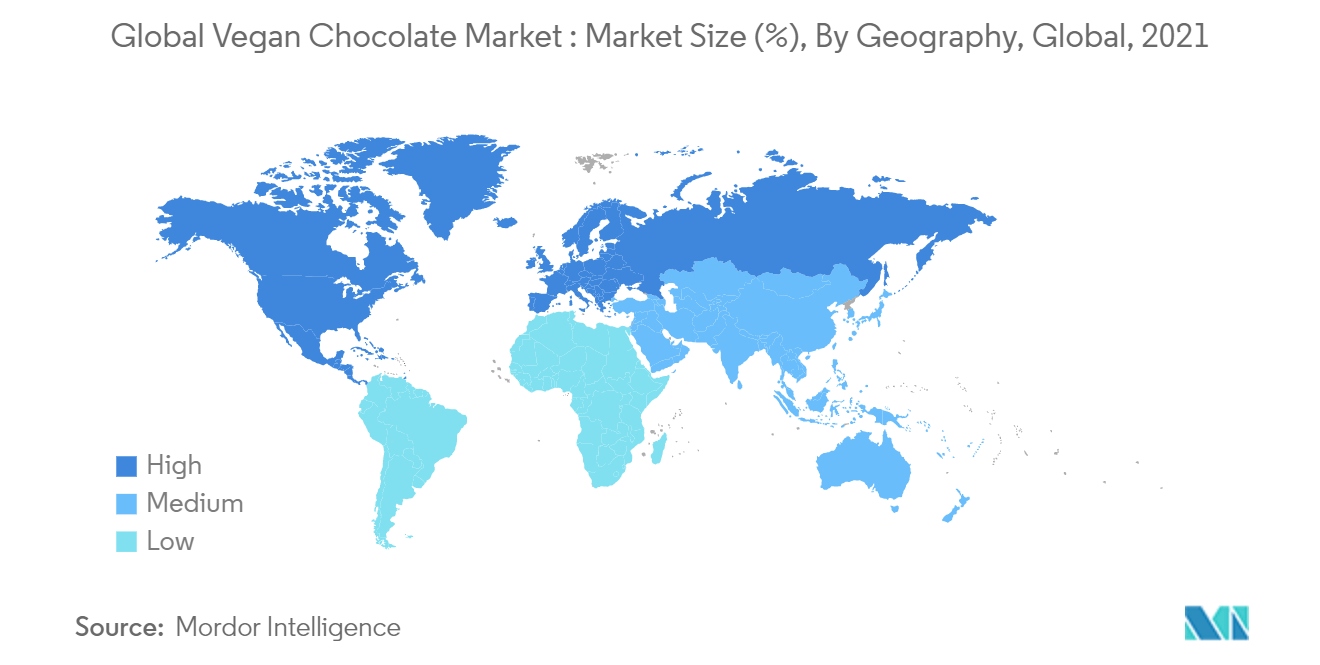
Vegan Chocolate Industry Overview
The market is characterized by the presence of a few well-established and several small- and medium-scale players. Companies are focusing on research and development activities to introduce new and innovative flavors in vegan chocolates. The rise in consumption of vegan chocolates can be ascribed to their distinctive flavor and nutritional properties. Companies are taking efforts to increase marketing and promotional activities to boost their revenue in the vegan chocolate market. Some of the key players operating in the global vegan chocolate market include Mars, Incorporated, Mondelēz International., Nestle SA, Tofutti Brands, Inc., Plamil Foods Ltd, and Barry Callebaut, among others.
Vegan Chocolate Market Leaders
-
Barry Callebaut
-
Tofutti Brands, Inc.
-
Mondelēz International.
-
Nestle SA
-
Mars, Incorporated
*Disclaimer: Major Players sorted in no particular order
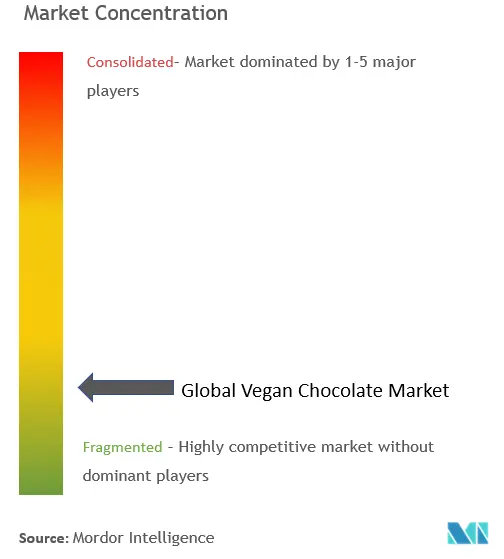
Vegan Chocolate Market News
- In June 2022, Mars, Incorporated in partnership with Perfect Day launched its first ever animal-free, lactose-free, and vegan-friendly chocolate called CO2COA in the United States market.
- In February 2022, Cadbury launched its first-ever plant-based vegan chocolate called the Cadbury Plant Bar, the chocolate comes in two flavors namely smooth chocolate and salted caramel. The vegan-certified bars include a blend of cocoa, almond paste, and rice extract and promise a lusciously smooth texture and all the goodness of chocolate.
- In February 2022, Lindt launched three new vegan chocolate bars in the United Kingdom and Canada, a year after it entered the free-from market with its HELLO collection. The new bars are made with oat milk and are available in three varieties namely original, hazelnut, and salted caramel in Canada and two varieties namely smooth and hazelnut in the United Kingdom.
Vegan Chocolate Market Report - Table of Contents
1. INTRODUCTION
- 1.1 Study Assumptions and Market Definition
- 1.2 Scope of the Study
2. RESEARCH METHODOLOGY
3. EXECUTIVE SUMMARY
4. MARKET DYNAMICS
- 4.1 Market Drivers
- 4.2 Market Restraints
-
4.3 Porter's Five Force Analysis
- 4.3.1 Threat of New Entrants
- 4.3.2 Bargaining Power of Buyers/Consumers
- 4.3.3 Bargaining Power of Suppliers
- 4.3.4 Threat of Substitute Products
- 4.3.5 Intensity of Competitive Rivalry
5. MARKET SEGMENTATION
-
5.1 By Chocolate Type
- 5.1.1 Milk Chocolate & White Chocolate
- 5.1.2 Dark Chocolate
- 5.1.3 Other Types
-
5.2 By Product Type
- 5.2.1 Boxed Assortments
- 5.2.2 Countlines
- 5.2.3 Others
-
5.3 By Distibution Channel
- 5.3.1 Supermarkets/Hypermarkets
- 5.3.2 Convenience stores
- 5.3.3 Online Stores
- 5.3.4 Other Distribution Channels
-
5.4 By Geography
- 5.4.1 North America
- 5.4.1.1 United States
- 5.4.1.2 Canada
- 5.4.1.3 Mexico
- 5.4.1.4 Rest of North America
- 5.4.2 Europe
- 5.4.2.1 United Kingdom
- 5.4.2.2 Germany
- 5.4.2.3 Spain
- 5.4.2.4 France
- 5.4.2.5 Italy
- 5.4.2.6 Russia
- 5.4.2.7 Rest of Europe
- 5.4.3 Asia-Pacific
- 5.4.3.1 China
- 5.4.3.2 Japan
- 5.4.3.3 India
- 5.4.3.4 Australia
- 5.4.3.5 Rest of Asia-Pacific
- 5.4.4 South America
- 5.4.4.1 Brazil
- 5.4.4.2 Argentina
- 5.4.4.3 Rest of South America
- 5.4.5 Middle East & Africa
- 5.4.5.1 Saudi Arabia
- 5.4.5.2 South Africa
- 5.4.5.3 Rest of Middle East & Africa
6. COMPETITIVE LANDSCAPE
- 6.1 Most Adopted Strategies
- 6.2 Market Share Analysis
-
6.3 Company Profiles
- 6.3.1 Mondelēz International
- 6.3.2 Nestle SA
- 6.3.3 Tofutti Brands, Inc.
- 6.3.4 Plamil Foods Ltd
- 6.3.5 Barry Callebaut
- 6.3.6 NestEndangered Species Chocolatele
- 6.3.7 Endorfin
- 6.3.8 Goodio
- 6.3.9 Montezumas Direct Ltd.
- 6.3.10 No Limit, LLC (Newman's Own Inc.)
- *List Not Exhaustive
7. MARKET OPPORTUNITIES AND FUTURE TRENDS
8. IMPACT OF COVID-19 ON THE MARKET
9. DISCLAIMER
** Subject To AvailablityVegan Chocolate Industry Segmentation
Vegan chocolates are made with plant-based ingredients such as cacao beans, soy milk, and maple syrup without adding any animal-related products like dairy products. The global vegan chocolate market is segmented by chocolate type, product type, distribution channel, and geography. By chocolate type, the market is segmented into milk chocolate & white chocolate, and dark chocolate. Based on the distribution channel, the market is segmented into supermarkets/hypermarkets, convenience stores, online retail stores, and other distribution channels. It provides an analysis of emerging and established economies across the world, comprising North America, Europe, South America, Asia-Pacific, and Middle-East & Africa. For each segment, the market sizing and forecasts have been done on the basis of value (in USD million).
| By Chocolate Type | Milk Chocolate & White Chocolate | |
| Dark Chocolate | ||
| Other Types | ||
| By Product Type | Boxed Assortments | |
| Countlines | ||
| Others | ||
| By Distibution Channel | Supermarkets/Hypermarkets | |
| Convenience stores | ||
| Online Stores | ||
| Other Distribution Channels | ||
| By Geography | North America | United States |
| Canada | ||
| Mexico | ||
| Rest of North America | ||
| By Geography | Europe | United Kingdom |
| Germany | ||
| Spain | ||
| France | ||
| Italy | ||
| Russia | ||
| Rest of Europe | ||
| By Geography | Asia-Pacific | China |
| Japan | ||
| India | ||
| Australia | ||
| Rest of Asia-Pacific | ||
| By Geography | South America | Brazil |
| Argentina | ||
| Rest of South America | ||
| By Geography | Middle East & Africa | Saudi Arabia |
| South Africa | ||
| Rest of Middle East & Africa |
Vegan Chocolate Market Research FAQs
What is the current Vegan Chocolate Market size?
The Vegan Chocolate Market is projected to register a CAGR of 13.70% during the forecast period (2024-2029)
Who are the key players in Vegan Chocolate Market?
Barry Callebaut, Tofutti Brands, Inc., Mondelēz International., Nestle SA and Mars, Incorporated are the major companies operating in the Vegan Chocolate Market.
Which is the fastest growing region in Vegan Chocolate Market?
Asia-Pacific is estimated to grow at the highest CAGR over the forecast period (2024-2029).
Which region has the biggest share in Vegan Chocolate Market?
In 2024, the Europe accounts for the largest market share in Vegan Chocolate Market.
What years does this Vegan Chocolate Market cover?
The report covers the Vegan Chocolate Market historical market size for years: 2019, 2020, 2021, 2022 and 2023. The report also forecasts the Vegan Chocolate Market size for years: 2024, 2025, 2026, 2027, 2028 and 2029.
Vegan Chocolate Industry Report
Statistics for the 2024 Vegan Chocolate market share, size and revenue growth rate, created by Mordor Intelligence™ Industry Reports. Vegan Chocolate analysis includes a market forecast outlook to 2029 and historical overview. Get a sample of this industry analysis as a free report PDF download.



